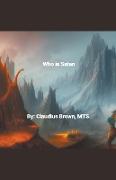- Start
- Who is Satan
Who is Satan
Angebote / Angebote:
The concept of Satan has been a controversial and widely debated topic throughout history. Depending on cultural and religious beliefs, Satan can be viewed as a symbol of evil, a fallen angel, a powerful demon, or a personification of human temptation. this introduction, we will explore various perspectives on who Satan is and how this figure has been represented in different traditions.
One of the most well-known depictions of Satan comes from Christianity, where he is commonly referred to as the devil. According to the Bible, Satan was once an angel in heaven, but he rebelled against God and was cast down to earth along with other fallen angels. In Christian tradition, Satan is seen as a tempter who lures humans into sin and encourages them to turn away from God. He is often depicted as a horned, red-skinned figure with a tail and a pitchfork, and is said to reside in hell, where he reigns over a host of demons.
In Islam, Satan is known as Iblis or Shaytan, and is also portrayed as a disobedient creature who defied God's command. According to Islamic teachings, Satan refused to bow down to Adam, the first human being created by God, and was banished from heaven as a result. In Islamic tradition, Satan is seen as an adversary who constantly tempts human beings to sin and encourages them to disobey God's commands. He is often depicted as a cunning, deceitful figure who uses his intelligence and wit to manipulate people.
In Judaism, Satan is known as the accuser or the adversary, and is sometimes seen as a prosecuting attorney in the heavenly court. According to Jewish teachings, Satan's role is to test human beings and to accuse them of wrongdoing before God. While he is not seen as the embodiment of evil in Judaism, Satan is often portrayed as a powerful and malevolent force that can cause harm to those who fall under his influence.
In popular culture, Satan has been depicted in various forms, ranging from the comedic to the terrifying. In films and television shows, he is often portrayed as a suave and charming figure who uses his charisma to manipulate people, while in literature and art, he is often depicted as a monstrous and terrifying creature who embodies pure evil.
Despite the diverse interpretations of who Satan is, there is a common thread that runs through all traditions - the idea that he represents the opposite of what is good and holy. Whether he is seen as a fallen angel, a demonic tempter, or a malevolent force, Satan is often portrayed as a figure to be feared and avoided. His influence is said to be dangerous and destructive, and those who fall under his sway are seen as being in grave danger.
Satan is a figure in many religions and mythologies, most notably Christianity and Islam. He is often seen as a powerful, malevolent being who tempts humans to sin and do evil. He is also known as the Devil or Lucifer.
The origin of Satan can be traced back to the Hebrew Bible, where he is referred to as ha-Satan (the accuser). In the New Testament, he is described as an angel who rebelled against God and was cast out of Heaven. He is then said to have become the ruler of Hell and the source of all evil in the world.
Throughout history, Satan has been depicted in various ways. In some traditions, he is seen as a fallen angel who tempts people into sinning and doing evil deeds. In other traditions, he is seen as a powerful force of chaos and destruction that must be resisted at all costs.
Generating a book on who is Satan will provide readers with an opportunity to explore this complex figure from multiple perspectives. It could include information about his origins, his role in different religious traditions, his influence on popular culture, and his impact on human behavior. The book also discusses how Satan has been portrayed throughout history and how his image has evolved over time.
Folgt in ca. 10 Arbeitstagen
